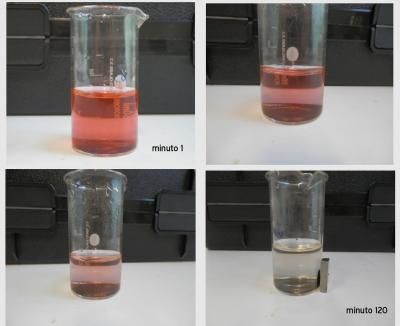Nanostructures to facilitate the process to eliminate organic contaminants in water
In her PhD thesis, Silvia Larumbe-Abuin has developed nanostructures that assist in the process to decontaminate water. The nanostructures are coated in titanium oxide to which nitrogen has been added. This allows sunlight, rather than ultraviolet radiation, to trigger the process involving the chemical reaction and destruction of contaminants. What is more, thanks to the magnetic nucleus of the particles, once the process has been carried out, they can be retrieved and reused.

This is the dissolution process of organic particles through nanoparticles.
Public University of Navarre (UPNA)
The basis of the research conducted is the phenomenon known as photocatalysis: when light affects a substance that acts as a catalyst, the speed of the chemical reaction is increased. In this case, the light activates the titanium oxide and different oxidizing radicals are formed; the latter destroy the organic contaminants in the water, which could be colouring agents, solvents, detergents, etc. As the author of the work explained, "it is a sustainable system that could be used as an alternative to different treatments used traditionally in waste water treatment and, specifically, to eliminate certain organic contaminants".
One of the advantages of this development is the possibility of using sunlight instead of ultraviolet light. "Since nitrogen is added to the coating of the particles, the mechanism that will trigger the process can be sunlight rather than ultraviolet radiation, which means a more accessible, less expensive alternative that poses fewer risks."
Most read news
Organizations

Get the analytics and lab tech industry in your inbox
By submitting this form you agree that LUMITOS AG will send you the newsletter(s) selected above by email. Your data will not be passed on to third parties. Your data will be stored and processed in accordance with our data protection regulations. LUMITOS may contact you by email for the purpose of advertising or market and opinion surveys. You can revoke your consent at any time without giving reasons to LUMITOS AG, Ernst-Augustin-Str. 2, 12489 Berlin, Germany or by e-mail at revoke@lumitos.com with effect for the future. In addition, each email contains a link to unsubscribe from the corresponding newsletter.























































